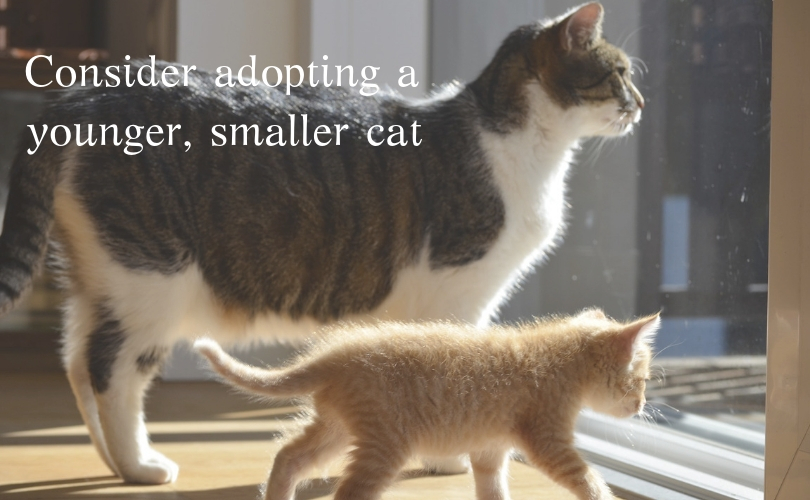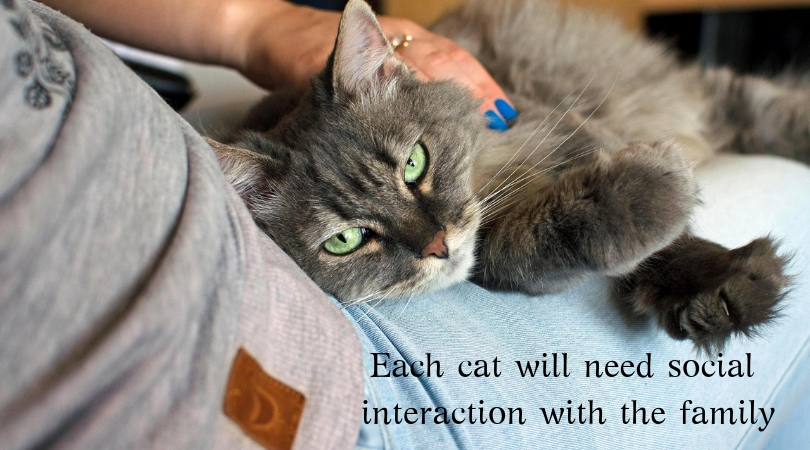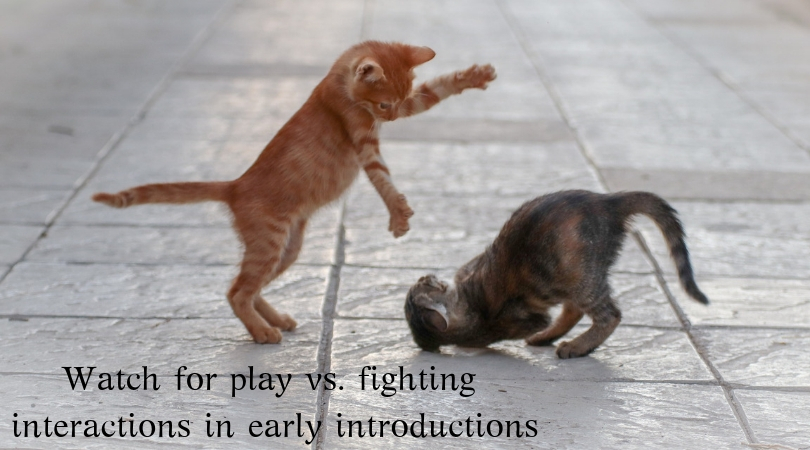As the warmer months arrive this year, so does “kitten season.” Most areas of the United States experience kitten season, when cats go into heat and begin having litters of kittens, between April and October. If you already have a cat and are considering adopting a kitten, or are bringing an older cat into your home where you already have a cat, it’s important that you take the proper steps of introducing the two cats together, including matching personalities, cat preventative care, environmental enrichment, and more.
If you were to suddenly gain a roommate in your home, you wouldn’t just start living together and hope that things work out – you’d make an effort to introduce yourself and hopefully get along. The same goes with cats – don’t just “throw them together” and hope for the best. Getting another cat will have a big effect on your resident cat, so it’s essential to take things slow and introduce your cats to each other appropriately. Here are some tips for adding a new cat (or cats) to a home with a single cat.
Personality Counts
First and foremost, consider your current cat. It may be very tempting to adopt a cute little kitten, but if you have a very laid-back, frail, or elderly cat at home, it is best to avoid kittens and/or very playful, rowdy cats. And vice versa. If you have a lively cat who is constantly bouncing off the walls of your house, getting a very calm or quiet, shy cat is probably not a good idea.
Age and sex might be the biggest factors to consider, outside of general personality: “In an ideal new cat/old cat matchup, the newcomer would be a younger and smaller cat that is fixed and of the opposite gender.” This can help you avoid conflict due to competitive instincts.

Protect your First Cat
When bringing a new cat into your home, it’s important to make sure your first cat can handle their new brother or sister, both mentally and physically. Physically, your first cat should be young and healthy enough to play with another cat. Schedule a visit with your cat’s veterinarian to ensure your cat is up to the task, as well as up-to-date on all wellness exams and vaccines. This is something you should be doing routinely anyway, but if you’re adopting a new cat from a shelter or organization, most will check if you’ve done this as part of your “background check.”
Mentally, you will want to make sure your first cat plays well with others. Cats can be very solitary creatures; not all cats want or need a second cat on their turf. If you’ve seen your current cat in the company of other cats with no excessive signs of aggression or fear, it may be possible to introduce a new cat into the household. However, if your cat regularly displays hostile behavior towards other cats, such as hissing, growling, or marking their territory if another cat enters your yard, then adopting another cat might not be a good idea.
Making a Proper Introduction
Once you have selected a potential new furry friend, it’s important to take the cat introduction process slowly. You’re probably very excited about your new kitty, but if you rush things and try to force an immediate feline friendship, you might end up accidentally ruining a relationship that would have worked out otherwise.
- Exchange the cats’ scents with one another. Ask the shelter or breeder if you can have a blanket the new cat has slept on to let your first cat smell. Also ask if it would be possible to bring the new cat a blanket from home that your original cat has slept on. This may not be possible in all cases, but if you can trade the cats’ scents with one another before they actually meet, you will be priming both cats for a proper introduction.
- Cats are territorial animals, so when you are introducing a second cat remember that they need to establish their own space within the home. Prepare a separate room where your new cat can adapt to your home and gradually learn to recognize your first cat. Make sure this “intermediary” room is a room where your other cat has been, that it can be easily accessed by all human family members for social interaction, and that it is set up with food/water, litter, toys, and a bed. Ideally, the room will have an inch or two of space under the door for your curious cats to safely introduce themselves through.

- Next, feed your cats on opposite sides of the door. By having the cats both experience something positive (a meal) while they are near each other, they can learn to form positive associations with each other. If one of the cats refuses to eat, try placing a tasty treat or snack on either side of the door. If either cat is growling or hissing through the door during mealtime, don’t put them together yet. Continue feeding your cats this way until any hostility subsides.
- Once both cats seem calm and relaxed while eating on their sides of the door, it’s time for another scent exchange. Put your first cat in the intermediary room and let your new cat explore the house. Each cat will now use the other cat’s food and water dishes, bed, toys, and litter box for the next few days. While your new kitty is learning all the areas of your home, continue to feed both cats on their own sides of the door.
- Once both cats are eating and using the litter box normally, the next step is to let them have visual contact and limited physical interaction. Open the separating door, but keep a pet gate of some sort across it so they can see, smell, and have contact with each other, but not complete access.
- Once both cats are acting, eating and using the litter box normally again, it’s time to take down the gate. If the cats seem to tolerate, enjoy, or interact with each other, that’s great! If there is hissing or they just straight up ignore each other, that could be fine, too. If there is outright aggression, or even a fight in which one of the cats is injured, you may need to separate them again and/or reassess if the new cat is a good match for your first cat.

- Monitor your cats carefully, and be sure to keep them in their separate rooms when you are not home to supervise. Once you have ensured that they are safely getting along, you can gradually start to leave them alone together for longer and longer periods of time.
Post-Introduction Tips
Even after your cats seem to be getting along, there are still a few things to keep in mind if you want to keep the peace.
- Get your new cat in for a check-up as soon as possible. You’ve already ensured your first cat is up-to-date on his or her wellness exams and vaccines; now it’s time to get your other cat checked out. Bring any and all existing medical history you have with you to the vet, and follow all recommendations for optimal feline nutrition, vaccines, and other preventative measures.
- Keep their food separate. Feeding your cats in one community food bowl can open the door to one cat bullying the other for first/more access to their food. By keeping their food in “assigned” bowls, you will uphold that both your cats always feel safe and secure while eating.
- Provide ample litter boxes, scratching posts, and napping options around your home. One basic rule is to have a litter box for each cat in your home, plus one extra. By providing multiple areas for your kitties to feel comfortable, you’ll reduce feline fretfulness in your home.
Keep Tabs on the Relationship
Throughout their lives, the relationship between your cats could shift. So it’s your responsibility to keep an eye on the body language of your cats. Changes in behavior can signal stress, illness, etc. and may signify that the roommate relationship is escalating into a toxic situation. Give each cat plenty of attention and exercise to keep them happy and satisfied, as well as to distract them from picking on each other. Using environmental enrichment to keep your cats content can definitely help to avoid a dangerous sibling situation.
There is no guarantee that your cat will thank you for the new addition to your family. However, if they have been sufficiently socialized to other cats, many cats do benefit enormously from other feline company. Just remember to take things slow, and you CAN have a harmonious multi-cat household. And be sure to contact us if you have any questions about the process!

